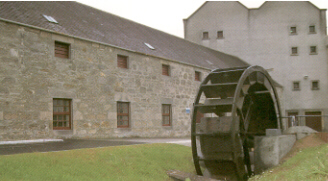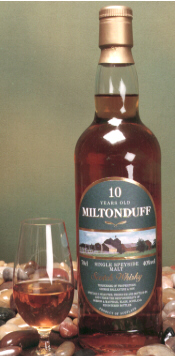
 Situated six miles southwest of Elgin is
Pluscarden Abbey. Initially a Priory it was founded by King Alexander II in 1230. In 1454
it absorbed the old Benedictine Priory of Urquhart, only to fall into disuse at the
Reformation. Almost 400 years later it was given to the Benedictine Community
of Prinknash by Lord Colum Crichton Stuart. The Community was able to take up residence in
1948, with restoration work still on-going. In 1974 Pluscarden was elevated to the status
of an abbey. During the nineteenth century there were in excess
of fifty illicit stills operating in the Pluscarden area. This was due both to the
abundant supplies of water and to the fertile land in the glen which produced ample
barley. Miltonduff Distillery is said to be situated on the site of the Abbey's
meal mill, two miles from the Abbey. A stone from the original Abbey is retained by the
distillery. The distillery's water source is the Black Burn which is fed by springs
rising by the Abbey. There is no such reciprocation of the Abbey being fed by Miltonduff
Single Malt Whisky.
Situated six miles southwest of Elgin is
Pluscarden Abbey. Initially a Priory it was founded by King Alexander II in 1230. In 1454
it absorbed the old Benedictine Priory of Urquhart, only to fall into disuse at the
Reformation. Almost 400 years later it was given to the Benedictine Community
of Prinknash by Lord Colum Crichton Stuart. The Community was able to take up residence in
1948, with restoration work still on-going. In 1974 Pluscarden was elevated to the status
of an abbey. During the nineteenth century there were in excess
of fifty illicit stills operating in the Pluscarden area. This was due both to the
abundant supplies of water and to the fertile land in the glen which produced ample
barley. Miltonduff Distillery is said to be situated on the site of the Abbey's
meal mill, two miles from the Abbey. A stone from the original Abbey is retained by the
distillery. The distillery's water source is the Black Burn which is fed by springs
rising by the Abbey. There is no such reciprocation of the Abbey being fed by Miltonduff
Single Malt Whisky.
 1824 - Miltonduff Distillery established on the
site of a meal mill at Pluscarden Abbey. Licensed to Andrew Pearey & Robert Bain.
1824 - Miltonduff Distillery established on the
site of a meal mill at Pluscarden Abbey. Licensed to Andrew Pearey & Robert Bain.
1866 - Distillery acquired by William Stuart.
1890 - William Stuart joined by Thomas Yool. Distillery expanded during the 1890's with annual production increased to 750,000 litres of alcohol.
1936 - Distillery and 200 acres of farmland are sold to Hiram Walker-Gooderham & Worts Ltd.
1964 - A lomond wash and spirit still are added to produce Mosstowie.
1974 - Distillery is rebuilt with the number of wash backs increased from 8 to 18.
1981 - Due to increased demand, Mosstowie stills altered to produce Miltonduff. Distillery now has a maximum annual output of 5.4 million litres of alcohol.
1992 - Distillery a subsidiary of Allied Distillers Ltd. (ADL)
INNOVATION
As well as the distillery, the Miltonduff complex also houses the following departments: Laboratories which analyse process and bio-plant samples from all ADL malt distilleries; an engineering department; centralised warehouse management and the Malt Distilleries Technical Centre which provides technical and business back-up to the distilleries. These activities have led to several innovative processes being pioneered at Miltonduff. In the 1960's a new method of heating the wash stills
was introduced. Passing the wash through a series of heat exchangers (using hot water from
the condensers) prior to charging the still would heat the wash to 75-80°C. Once the
still had been charged, wash would then be drawn and passed through another heat exchanger
where steam would heat the wash to boiling point. The vapourised wash would be returned to
the still via a diffuser and in turn heat the residual wash in the still. This would
continue until the distillation was complete.
In the 1960's a new method of heating the wash stills
was introduced. Passing the wash through a series of heat exchangers (using hot water from
the condensers) prior to charging the still would heat the wash to 75-80°C. Once the
still had been charged, wash would then be drawn and passed through another heat exchanger
where steam would heat the wash to boiling point. The vapourised wash would be returned to
the still via a diffuser and in turn heat the residual wash in the still. This would
continue until the distillation was complete.
The dangers of CO2 produced during fermentation are well known. Mesh flooring and good ventilation was the traditional solution. It was Miltonduff which introduced CO2 extraction. The 18 wash backs are completely enclosed, with the CO2 being drawn off by extractor fans.
MOSSTOWIE
From 1964 to 1981 Miltonduff also produced another whisky - Mosstowie. In 1955 due to the increased demand from within Hiram Walker for different styles of whisky, a chemical engineer, Alistair Cunningham, designed the Lomond still. This new type of still had a wide neck which housed three rectifying plates. The purpose of the plates was to vary the amount of reflux that took place within the still and so vary the style of malt whisky produced. The plates could either be filled with cool liquid to increase the amount of reflux, or left dry. They could also be rotated - the horizontal position would maximise the refluxing action while the vertical position would produce the least amount of reflux.Production of Mosstowie was ceased in 1981 due to two reasons - the rectifying plates would become coated in residue causing process problems, heat transfer, increased cleaning, etc and there was an increased demand for Miltonduff whisky - the main component of Ballantines Blend. A 1979 distillation of Mosstowie is available as part of the Gordon & MacPhail Connoisseurs Choice range. It has a lighter style to that of the Miltonduff with fruity, smoky, earthy notes.
Three other Hiram Walker distilleries had Lomond stills installed: Inverleven, which produced Lomond; Glenburgie which produced Glencraig, and Scapa where a Lomond wash still was used to alter the style.
DISTILLERY STATISTICS
| Malt Source | Kilgour/Munton |
| Malt Type | Various - Prisma, Derkado, Optic |
| Malt Storage | 8 Malt Bins, holding a total of250 tonnes |
| Mill Type | Porteus |
| Grist Storage | 1 Hopper, holding 15 tonnes |
| Mush Tun Construction | Stainless steel - semi-lauter |
| Mash Size | 14.5 tonnes |
| No. of Wash Backs | 18 |
| Wash Back Construction | Stainless steel |
| Wash Back Capacity | 38,000 litres |
| Yeast | Brewers & Distillers |
| No of Wash Stills | 3 |
| Wash Still Charge | 17,000 litres |
| Heat Source | External heat extraction |
| No. of Spirit Stills | 3 |
| Spirit Still Charge | 17,000 litres |
| Heat Source | Steam kettle |
| Cask Storage Capacity | 54,000 casks |
| Current Annual Distillery Output | 3.5 million litres of alcohol. |
MILTONDUFF STILLS
 All of the Miltonduff stills, 3 wash
and 3 spirit, have the traditional, "onion" shape. They are approximately 15
foot high with the lyne arm having a relatively steep drop at approximately 30°. The wash
stills have a capacity of 18,000 litres and the spirit stills 17,500 litres. They are both
charged with 17,000 litres. The wash distillation takes 5¼ hours and the spirit
distillation 8 hours.
All of the Miltonduff stills, 3 wash
and 3 spirit, have the traditional, "onion" shape. They are approximately 15
foot high with the lyne arm having a relatively steep drop at approximately 30°. The wash
stills have a capacity of 18,000 litres and the spirit stills 17,500 litres. They are both
charged with 17,000 litres. The wash distillation takes 5¼ hours and the spirit
distillation 8 hours.
The stills play their part in giving Miltonduff its desired character - flowery with hints of peat, heather and honey.
Read our tasting notes for Miltonduff and Mosstowie Whisky.
Home | History | Sample Room | News | Product Range | Distillery Profiles | Shop